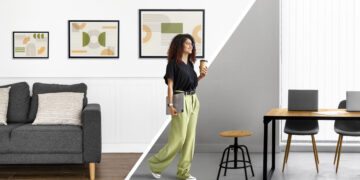The turn of a season is a natural reset. Light shifts, routines change, and your rooms start asking for different textures, colors, and energy. The Home Advice Decadgarden approach is simple and practical: modern comfort, mindful edits, and choices that feel good now and still make sense later. This guide walks you through a room-by-room refresh that blends quick wins with deeper improvements, so your home feels calmer, more personal, and ready for what’s next.
Quick wins
When time is tight, small changes do the heavy lifting. Swap in seasonal textiles on sofas and beds for instant warmth or breeziness. Edit one surface—a coffee table, dresser, or shelf—keeping what you love, removing the rest, and adding a single statement piece for focus. Relight a neglected corner with a floor lamp or a rechargeable table lamp to soften shadows and widen the room’s feel. These three steps alone can shift mood, flow, and function in a single afternoon.
Set the tone
Every new season benefits from a clear tone. Choose one accent color and one grounding neutral that you can repeat lightly across rooms—pillows, throws, flowers, a painted frame—to create a quiet thread of continuity. Play with texture as much as color: swap slick finishes for matte ceramics, crisp cottons for wool or bouclé, fine weaves for chunkier knits. Bring in natural elements. Branches, grasses, or seasonal flowers placed in an oversized vessel add height and life without clutter. Scent and sound shape the atmosphere as profoundly as sight. A citrus or herbal diffuser in spring, cedar or eucalyptus in cooler months, and a soft playlist matched to your evening rhythm can settle the whole space.
Living room
Start with surfaces. Group objects on trays, stack books with a single sculptural piece, and leave negative space so the eye can rest. A simple “2 textures, 1 pattern, 1 solid” mix for pillows keeps the sofa balanced without fuss. Layer your lighting: overhead for broad brightness, a task lamp for reading, and warm accent lights for glow points. Aim for bulbs around 2700–3000K in living spaces to maintain warmth without yellowing; dimmers help you shift mood throughout the day. Tame visual noise by guiding cables through sleeves and using baskets or lidded boxes to corral remotes and chargers. If traffic patterns feel cramped, consider the rule of comfortable pass-throughs: leave at least a couple feet of walkway and avoid furniture slivers that pinch flow. These changes make the room feel bigger, even if nothing moved more than a few inches.
Bedroom
Treat the bed as the anchor. A dependable base set—fitted sheet, pillowcases, and duvet—paired with a seasonal layer like a quilt in warm months or a wool blanket in cool months feels tailored and practical. Add a throw at the foot for warmth and color. Keep nightstands calm: a lamp at eye level when seated, one current book, and a small living touch like a stem or low-care plant. Do a hanger swap in the closet to rotate in seasonal items and set aside off-season clothing for storage; the visual clarity reduces morning friction. If you struggle with sleep, focus on light. A mix of blackout options and sheer curtains gives you darkness at night and soft natural light in the morning. Aim for a consistent sleep window, cooler room temperature, and low-light lamps in the last hour of your day; these habits are proven to support better rest.
Kitchen
A seasonal refresh in the kitchen is about function as much as looks. Divide counters into simple zones—prep, cook, serve—and clear each zone of items that don’t belong. Style just one area, like a tray with oil, vinegar, salt, and a favorite utensil crock near the stove. If you have open shelving, bring order through repetition: stack plates by color family, group mugs, and add a small plant for movement. Refresh a tea or coffee station with clean canisters, a fresh scoop, and a seasonal mug rotation to keep the ritual feeling special. Add a small herb corner or a jar of cut herbs; even if you don’t cook often, fresh green on the counter signals life and intention. While you’re at it, check under-sink storage and ventilation—clear out expired cleaners and consider a charcoal filter if odors linger.
Bathroom
Bathrooms lift with small, high-impact changes. Rotate linens by season and keep two sets per person for easy laundry cadence. Choose one seasonal accent color and repeat it in towels or a bath mat; this alone can shift the room’s tone. Decant daily essentials into simple, easy-to-clean containers to reduce label noise and create a spa-like feel. A small tray or riser keeps the counter calm. If the mirror feels dull, upgrade to bulbs with high color rendering so skin tones look accurate and the space feels clear; check for adequate ventilation to prevent fog and mildew. Scent matters here: eucalyptus or citrus in warm months for crispness, cedar or lavender in cooler months for coziness.
Entryway
First impressions set the day’s mood. Create a catch-all system with three elements: a bowl for keys, a hook for bags, and a tray or shoe rack. Separate shoes into daily pairs and overflow storage so the floor doesn’t sprawl. If square footage is tight, go vertical with peg rails, slim shelves, or wall-mounted hooks. Set a quick wipe routine—thirty seconds when you walk in with a microfiber cloth and a small bin nearby for mail. Refresh mats seasonally; clean bristles and non-skid backing extend their life and keep dirt out of the rest of the house.
Work corner
Even if your office is a corner of the living room, clarity pays you back in focus. Hold to a one-surface rule: laptop, a light source, and a single personal object. Add a cable sleeve and an under-desk hook for headphones to keep tangles out of sight. Style your video background with a small plant, a framed piece, and one clean shelf to reduce on-camera clutter. Task lighting that hits the desk from the side prevents glare and eye strain. Adjust chair height so your forearms are roughly parallel to the desk and your feet rest flat or on a footrest. Small posture tweaks compound into less fatigue over long days.
Color and pattern
A seasonal palette prevents scatter. Choose three base hues you already own, one or two accents that feel fresh, and a single metal finish you can repeat in frames or hardware for coherence. When mixing patterns, vary the scale: pair one large pattern with one small, and ensure they share at least one color. If you crave a change without a heavy commitment, paint a door, trim, or a single frame instead of a whole wall. Removable wallpaper or decals can be the perfect seasonal lift in rentals; apply to a small zone like the back of a bookcase or an entry niche for impact without overwhelm.
Textiles and layers
Textiles are the quickest seasonal dial. In warm months, lean into cottons and linens that breathe and move. When temperatures drop, trade in wool blends, bouclé, and heavier knits. Layer sheers to diffuse light while keeping privacy, and add liners or heavier drapes when you need warmth. Rug placement anchors rooms: front legs of sofas on the rug stabilize a seating area, while a flatweave over a larger neutral rug adds depth and softness. Keep care practical—wash covers on gentle cycles, rotate cushions, and vacuum rugs regularly to extend their life. A consistent care rhythm keeps textiles looking new through many seasons.
Lighting that lifts
Good lighting reshapes a room without moving walls. Use four layers: ambient for overall brightness, task for direct work, accent for emphasis on art or architectural details, and decorative lighting for mood. Warm temperatures around 2700–3000K suit living and sleeping spaces, while kitchens and work zones may benefit from neutral-white bulbs that keep colors accurate. Dimmers and smart plugs allow you to adjust levels across the day without rewiring. Candlelight or rechargeable lamps add flexible glow, especially in corners that feel flat. The goal is balance: no harsh glare, no gloomy pockets, and the ability to pivot from bright function to soft unwind with a single switch.
Storage and flow
Clutter is often just delayed decisions. Introduce a reset basket in each room to scoop up stray items and return them to their homes once a day. Try a simple 10/10 method: remove ten items from a space, then add back ten percent fewer; this gentle constraint creates breathing room without feeling punitive. Hidden storage—ottomans, benches, under-bed bins, over-door shelves—keeps necessities nearby without visual noise. Test room flow by walking common paths and noticing where you brush furniture or sweep curtains. Sometimes shifting a rug a few inches or rotating a side table is enough to open a route.
Nature and art
Living elements bring steadiness. Rotate in seasonal stems or branches; even a single tall branch in a generous vase can command a corner. If you enjoy art, pick frames that open easily and swap images seasonally; this is a simple way to keep walls feeling alive. Create a small memory shelf with a photo, a travel memento, and a found object like driftwood or a stone—arranged, not scattered—so sentimental pieces feel intentional. Choose easy plants that suit your light: snake plant, pothos, or ZZ plant for low light; herbs, hoya, or rubber plant for brighter areas. Success with plants is mostly about matching species to light and watering regularly but not excessively.

Budget upgrades
You don’t need a full renovation to feel renewed. Small, high-impact updates go far: change cabinet hardware, swap lampshades for better proportion and diffusion, and replace tired switch plates with clean ones that match your metal finish. Secondhand sources are excellent for mirrors, side tables, stools, and frames; older pieces often carry better materials and character. Simple DIYs—fabric-covered pinboards, painted stripes, or slipcovers—add polish. Save splurges for items that carry daily load: a supportive mattress, a sturdy sofa frame with replaceable cushions, and reliable lighting.
Future-friendly choices
A home that grows with you wastes less and works more. Choose durable, repairable items over disposable ones. Favor fabrics that clean well and resist pilling, and pick furniture with replaceable parts like cushion covers or modular components. Energy-smart habits—right-sized bulbs, closing blinds during peak heat, setting thermostats thoughtfully—reduce bills and wear on systems. Multi-use furniture, such as nesting tables or a bench with storage, adapts as rooms evolve. Buying once and buying better can be as simple as a checklist: will I use it weekly, can I maintain it, does it work in more than one room, and does it complement what I own?
Micro-projects
Short, focused projects create momentum. Restyle a single bookshelf: remove everything, dust, then rebuild with stacks, vertical rows, and a few objects for rhythm. Paint a door or frame in a contrasting color for a crisp edge. Replace a few cabinet handles to test a new finish before committing to the whole room. Set up a tray for a daily ritual—coffee, tea, or evening wind-down—so the habit feels anchored. Tackle one drawer with dividers; the daily convenience will nudge you to keep going.
One-weekend plan
Turn good intentions into a schedule. On Friday, gather supplies, finalize your palette, and declutter hotspots like entry surfaces and coffee tables. Saturday is for textiles, lighting, and surface styling: swap pillows and throws, add or move a lamp, and edit decorative objects. Sunday, rotate art, bring in greenery, and do a final clean and adjust. Take simple before-and-after photos from the same angle in natural light so you can see how much you achieved; the visual proof keeps motivation high for next time.
Common mistakes
Avoid buying decor before you edit what you own. Too many small objects dilute impact; one strong piece beats several fillers. Mind your bulb temperatures—mismatched lighting can make rooms feel off even when everything else is right. Measure before you buy rugs, curtains, and frames; scale is everything. Finally, remember maintenance: replace filters, check seals, tighten loose hardware, and swap burnt bulbs. Small upkeep beats big fixes later.
Photo prompts
Capture a single corner, a shelf, or a tabletop. Use the same angle and natural light, skip flash, and note three changes you made. Keep the frame simple so the improvements read clearly. If you share your progress, invite feedback on which change made the biggest difference; outside eyes often notice order and light before anything else.
Wrap up
A new season doesn’t demand a new house. It asks for a fresh look at what you already have and a handful of thoughtful shifts. The Home Advice Decadgarden approach keeps you grounded: calm rooms, useful choices, and personal touches. Start small, pick a color and a texture, swap a light, and edit one surface. Then set a date for the next seasonal reset. Homes evolve best in measured steps, and each season offers another chance to make yours feel more like you—welcoming, functional, and quietly beautiful.
Notes on sources and good practice
This guide draws on practical principles from interior design, building science, and habit formation. Warm-white lighting in living and sleeping areas is widely recommended for comfort and accurate rendering at night. Layered lighting and dimmers provide flexibility and reduce eye strain in the evening. Good sleep hygiene benefits from consistent schedules, cooler temperatures, and gentle, low-light conditions before bed. Durable materials, routine maintenance, and incremental improvements generally extend the life of furnishings and reduce overall costs. These are steady, field-tested practices that align with a future-friendly home.
FAQs
How do I start a quick seasonal refresh without buying much?
Begin with what you own. Swap textiles between rooms, edit one surface, move a lamp to a dim corner, and bring in a branch or greenery. Small shifts reset mood fast.
What’s the simplest color update for a new season?
Pick one accent and one neutral. Repeat them lightly in pillows, throws, a vase, or a painted frame. Keep the rest calm so the accent reads clearly.
How can I make my living room feel bigger without rearranging everything?
Open walk paths, clear visual clutter, and layer lighting. A couple of feet of clearance, fewer small objects, and warm, dimmable lamps expand the feel.
What’s the best lighting temperature for cozy rooms?
Aim for warm-white bulbs around 2700–3000K in living and sleeping areas. Use dimmers to shift from task-bright to evening-soft.
How do I refresh on a budget and still feel elevated?
Change hardware, swap lampshades, style trays, and hunt secondhand for mirrors and side tables. Save splurges for daily-use pieces like a sofa, mattress, and key lamps.












































